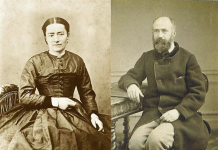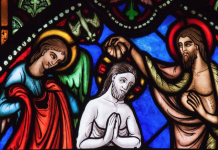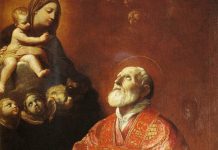
by Kate Ristow
This is one of those rare years when the celebration of Easter is so early — March 27 — that many of us will have several class sessions following this “Feasts of feasts” (CCC, 1169) to explore the fullness of the Easter season—up to and including Pentecost on May 15, the midpoint of the month, when many programs traditionally wrap up their catechetical year. Along the way, you can introduce students to saints whose lives honor in a special way the new life Jesus won for us on that first Easter and help the children explore and celebrate some of the feasts of the season.
Understanding the Categories of Church Celebrations
The Easter season is a wonderful time to teach students about the different rankings of Church celebrations. Although we often use the generic word “feasts” to describe the cycle of celebrations we observe during the course of the Church year, there are four different ranks that highlight their significance: solemnities, feasts, memorials (obligatory) and optional memorials.
Solemnities celebrate major events in the life of Jesus or Mary and the greatest mysteries of our faith. Examples of solemnities are Easter, Christmas, Epiphany, and the Annunciation. We also celebrate solemnities to honor specific titles or descriptions of Jesus or Mary, such as the Most Sacred Heart of Jesus, Christ the King, the Most Holy Trinity and Mary, Mother of God. Included are holy days of obligation and days that honor saints who played a pivotal role in salvation history: such as the Solemnity of Saints Peter and Paul and the birth of John the Baptist.
Feasts also commemorate mysteries of our faith and events in the life of Jesus, Mary, and other people who played an important role in Church history. Feasts, while central to our celebrations of the faith, are of less significance than solemnities. Examples of feasts are the Transfiguration of the Lord and Holy Family; they include celebrations honoring the evangelists and apostles.
Memorials most often venerate specific saints and martyrs throughout history, including those canonized in our time. Certain memorials are set aside to celebrate something about Mary (Our Lady of Sorrows on September 15). We are required to observe obligatory memorials. However, we must not think that optional memorials are unimportant. They give us the opportunity to honor an individual whose life shows us how to live as a disciple of Christ and who now shares life everlasting with God.
* Bring print resources, like the Roman Missal or a Church year calendar to your session. Challenge the students to find examples of solemnities, feasts, and memorials.
* Invite the children to look up the date on which the Church celebrates their name saint. Have them read the brief summary of their name saint’s life using facts from biographies of the saints.
Activities for Celebrating the Easter Season
* Easter is a time for remembering our baptism and the new life we received from Jesus. Make water a focal point of each of your sessions in a variety of ways. Ask a priest or deacon to conduct a sprinkling rite with holy water. Have the children stand as the priest walks through your learning space. As the priest blesses you with water say: “We praise your Resurrection and thank you for the new life of baptism.” Have the children bless themselves with the Sign of the Cross as they respond, “Alleluia!”
* Place a holy water font or bowl at the entrance to your classroom. Encourage the students to bless themselves as they enter and leave your sessions.
* Encourage students to bring home a small bottle of holy water so their families can bless themselves at home. Remind them that we are called to continue Jesus’ work and that we are called to be Christ’s hands in the world today.
Celebrating the Ascension
The Ascension of the Lord is a solemnity. Many Catholics still think of it as “Ascension Thursday,” although with the exception of the ecclesiastical provinces of Boston, Hartford, New York, Newark, Philadelphia, and Omaha, Catholics in the United Sates celebrate the Ascension on the 7th Sunday of Easter—43 days after the resurrection.
Have older students use the internet to learn how a diocese differs from an ecclesiastical province. If you teach in one of the ecclesiastical provinces have them choose one of the provinces and list the dioceses that are in the province.
Have older students compare and contrast the Biblical accounts of the commissioning of the disciples and the Ascension (Matthew 28:16-20; Mark 16:14-20; Luke 24:50-51; Acts 1:6-11). Paraphrase the story for younger children. Emphasize that before he returned to his father, he gave the disciples a mission. Explain that the Church today continues that mission. Distribute parish bulletins and have the children work in small groups to find three or more ways your parish continues the mission of Jesus.
Celebrating Pentecost
* Read aloud the story of Pentecost from Acts 2:1-14. Invite the students to write a five to seven sentence speech they might give to tell others about Jesus, as Peter did on that first Pentecost.
* Give each student a votive candle as a reminder of the tongues of fire that appeared when the Holy Spirit came to the disciples. Encourage them to place it in a fire-safe dish on the family dinner table at home and light the candle when the family eats together. Suggest that they take time as a family to name the gift or fruit of the Holy Spirit they see “shining” in one another. Mom is joyful; Dad is understanding, and so forth.
* Recall that the gifts of the Holy Spirit are strengthened in us at confirmation. Invite a recently confirmed teen or young adult to visit your class to talk about the preparation process and the difference he or she thinks confirmation will make in their life.
* Review the meaning of each of the gifts and fruits of the Holy Spirit. Distribute art supplies and invite the kids to make a design that represents the gift or fruit they most want to grow in. Give them scissors and yarn so they can cut out and hang their completed design in the bedrooms.
Saints to Celebrate
May 3—The Feast of Sts. Philip and James the Less, Apostles. We honor these two saints on the same day, not because they are brothers, as is commonly believed, but because they are buried together even though they were martyred at different times and in different places. Both of them certainly took seriously Jesus’ call to “make disciples of all nations” (Matthew 28:19).
* Invite the children to wear red at the session closest to May 3. Explain that on feast days which honor the martyrs, the priest wears red vestments to represent the blood that was shed when they died. Explain that by wearing red, they honor Philip and James and all who have died for their belief in Christ.
* Have the children read John 14:8 to discover what Philip said to Jesus at the Last Supper. Discuss what Philip’s words tell us about his faith.
* Share with the students accounts of Philip’s and James’ lives. Invite the children to complete the following sentence: “The lives of Saints Philip and James inspire me to ….”
April 29—Memorial of St. Catherine of Siena. St. Catherine lived an extraordinary life and is an example to people of all ages. She is credited with helping restore unity to the Church by working to bring the rightful pope back to Rome from France. She served the sick and the poor and was a living example of the works for mercy. Although she did not learn to write until she was an adult, her spiritual writings, many of them letters, are such a treasure to the Church that Pope Paul VI declared her a doctor of the church, a title given only to the greatest teachers of our faith.
* Ask students to do internet research on the life of St. Catherine. Have them discover why the symbols of a lily, a thorn, and a heart are all associated with her.
* Review the works of mercy with your class. Brainstorm with the students ways they can better live these actions in their own lives, as St. Catherine did.
* Catherine wrote letters to the pope urging him to return to Rome to lead the Church. Discuss with the students what they would write to Pope Francis if he asked for their advice.
CLICK HERE to download a Pentecost worksheet for the children to complete. Here is the answer key: A-4; B-2; C-5; D-1; E-8; F-3; G-6; H-7
Kate Ristow, contributing editor to Catechist, has worked in Catholic publishing for more than 30 years as a national speaker and writer, building on a wealth of experience in the religious formation of children and catechists in both parish and Catholic school programs.
Copyright 2016, Bayard, Inc. All rights reserved. This article is protected by United States copyright and other intellectual property laws and may not be reproduced, rewritten, distributed, redisseminated, transmitted, displayed, published or broadcast, directly or indirectly, in any medium without the prior written permission of Bayard, Inc.
This article was written by the Catechist Staff and appeared in Catechist magazine, June 2016.
Image Credit: Thoom/Shutter Stock 559092118




